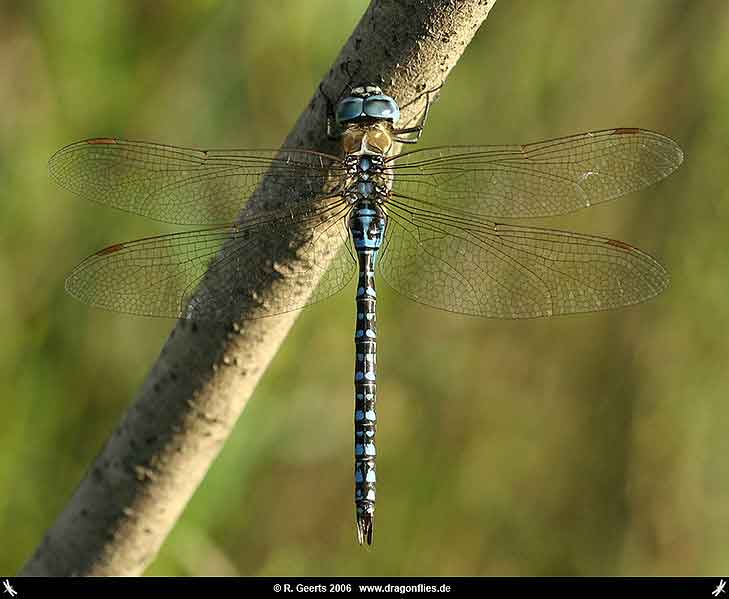
Aeshna affinis (*)
Superregnum: Eukaryota
Regnum: Animalia
Subregnum: Eumetazoa
Cladus: Bilateria
Cladus: Nephrozoa
Cladus: Protostomia
Cladus: Ecdysozoa
Cladus: Panarthropoda
Phylum: Arthropoda
Subphylum: Hexapoda
Classis: Insecta
Cladus: Dicondylia
Subclassis: Pterygota
Cladus: Metapterygota
Cladus: Odonatoptera
Cladus: Holodonata
Ordo: Odonata
Subordo: Epiprocta
Infraordo: Anisoptera
Superfamilia: Aeshnoidea
Familia: Aeshnidae
Subfamilia: Aeshninae
Tribus: Aeshnini
Genus: Aeshna
Species: Aeshna affinis
Name
Aeshna affinis Vander Linden, 1820
References
Links
IUCN: Aeshna affinis (Least Concern)
Vernacular names
Deutsch: Südliche Mosaikjungfer
suomi: Hohtoukonkorento
magyar: Gyakori acsa
Nederlands: Zuidelijke glazenmaker
polski: żagnica południowa
Aeshna affinis, the southern migrant hawker or blue-eyed hawker, is a dragonfly found in southern Europe and Asia. It is in the family Aeshnidae and is very similar in appearance to A. mixta.
Identification
Top view, female
Aeshna affinis is a small Aeshna and very similar to the related A. mixta with which it is easily confused. As its name suggests the male has blue eyes and also blue marking on the abdomen. A. affinis lacks the yellow T-shaped mark which is found on the top of the second abdomen segment in A. mixta. The markings on the side of the thorax are also different in A. affinis and A. mixta. In A. affinis the sides of the thorax are greeny yellow with fine black lines along the sutures. In A. mixta the sides of the thorax are similar in colour but the yellow is separated by dark brown areas so it gives the appearance of having two broad yellow stripes
Distribution and habitat
Aeshna affinis is found in southern and central Europe and all around the Mediterranean, in North Africa and the Middle East and across Asia to China. It is found on many Mediterranean islands including Menorca, Corsica, and Sicily. Where it occurs with A. mixta, which has a more northerly distribution, it is less common. It is a migrant species and so is found further northwards in good years.
Behaviour
A. affinis in copula.
Adults emerge in May and are on the wing until September. After emergence the immature adults move away from water and spend a time feeding and becoming sexually mature. This period will last 10 days to many weeks. Males are often seen patrolling low down whereas A. mixta tends to patrol higher up in the trees. After maturation the males patrol well vegetated ponds and lakes looking for females. The female will be grabbed and the pair will copulate. After sperm is transferred the male A. affinis stays with the female for egg laying which is usually in vegetation. A. affinis is the only European Aeshna to lay its eggs in tandem; the only other European hawker to lay eggs in tandem is Anax parthenope. The laval stage usually lasts two years.
References
Askew, R.R. (2004) The Dragonflies of Europe. (revised ed.) Harley Books. ISBN 0-946589-75-5
d'Aguilar, J., Dommanget, JL., and Prechac, R. (1986) A field guide to the Dragonflies of Britain, Europe and North Africa. Collins. pp336. ISBN 0-00-219436-8
Boudot JP., et al.. (2009) Atlas of the Odonata of the Mediterranean and North Africa. Libellula Supplement 9:1-256.
Dijkstra, K-D.B & Lewington, R. (2006) Field Guide to the Dragonflies of Britain and Europe. British Wildlife Publishing. ISBN 0-9531399-4-8.
Utzeri, C., and Raffi, R. (1983). Observations on the behaviour of Aeshna affinis (Vander Linden) at a dried-up pond (Anisoptera:Aeshnidae). Odonatologica 12:259-278.
Retrieved from "http://en.wikipedia.org/"
All text is available under the terms of the GNU Free Documentation License

